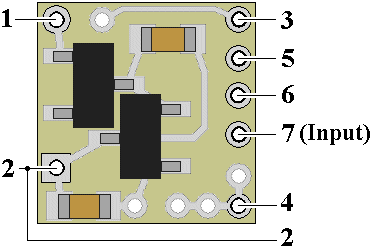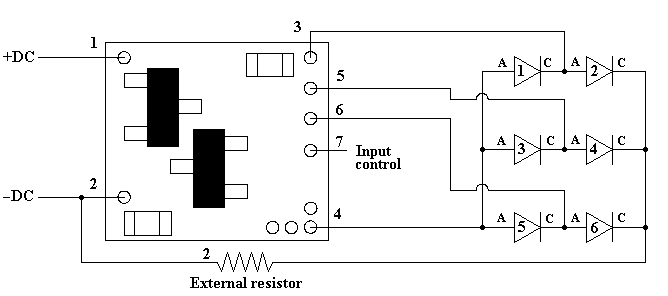Best viewed using:
Internet Explorer
or
Mozilla Firefox
Connecting the N8049 / N8049A Chase Light Simulator
Installing the N8049 is very straightforward. Its tiny size and thin construction will allow it to be placed in many locations, even in the smallest scale structures. Because the module has circuitry on both sides, care must be taken to be sure that the components or wires soldered will not make contact with any metal object (such as a locomotive frame) causing a short circuit.
Included with the module are three 6” lengths of #32 insulated wire. If necessary, these can be used for power and input control wires. If used, we recommend the blue wire be used for the + DC connection. It would be connected to solder point 1 as shown in Fig. 1. This wire could also connect through a switch to the + DC connection for remote control of the lighting effect. The other (green) wire should be connected to – DC and to solder point 2.
Solder point 7 is used for input control. When this point is connected to ground (-DC), the N8049 changes from sequentially lighting the LEDs (1 through 6 over and over) to up and down scaling (1,2,3,4,5,6,5,4,3,2,1 over and over). The sequencing rate is approximately 1.5 seconds to step through the 6 LEDs.
Any well regulated DC power source can be used to power this module providing the voltage is at least 6VDC and doesn't exceed 18VDC. Our N3512 and N3518 Power supplies are ideal for this use. Also, due to the very low power consumption, this device can also be powered by a battery, such as a standard 9-volt.
Important note: A low-wattage iron with a pointed tip should be used for connection of wires. Too much heat or solder can easily damage the wires or module and void the warranty.
Also, all connecting wires should be pre-tinned before soldering them to the module. This will make connection quick and easy and ensure excessive heat is not applied to the solder points.

Figure 1
Connecting LEDs
When connecting the LEDs, proper polarity must be observed. LEDs are “polarity sensitive” and will not function if connected backwards. The N8049 is configured to allow the connection of six (6) 20 ma LEDs with device voltages of 3.2-3.6 VDC. This covers Ngineering’s 2x3 white and Incandescent LEDs, Micro white and yellow-white LEDs, and Nano white LEDs, as well as many white LEDs available.
The N8049A version of this simulator is for LEDs six (6) 20 ma LEDs with device voltages of 1.75-2.0 VDC. This covers Ngineering’s Micro and Nano red and yellow LEDs, as well as many red and yellow LEDs available.
In the wiring diagram below (Fig.2), the LEDs are shown with numbers 1 through 6 for clarity and have their anode (+) and cathode(-) connections identified by A and C.
Note that the six LEDs are essentially connected as 3 series-pair groups (1 to 2, 3 to 4, 5 to 6).
Also note that all of the odd numbered LEDs have their anodes connected together and are then connected to the solder point 4.
Further, note that all of the even numbered LEDs have their cathodes connected together and are then connected in series with an external resistor (supplied with the N8049) and then connected back to solder point 2.
The N8049 controls the lighting of the 6 LEDs with control wires connected as follows:
Solder point 3 is wired to the junction of LED 1 cathode and LED 2 anode.
Solder point 5 is wired to the junction of LED 3 cathode and LED 4 anode.
Solder point 6 is wired to the junction of LED 5 cathode and LED 6 anode.
Using wire appropriate for the size of the LEDs and their placement in the project, connect the LEDs as shown in Fig. 2 below.

Figure 2
Once again, be sure to use a low-wattage soldering iron when connecting wires to the module. Our N40M2 12-watt Iron with either the N408I (iron clad) Needle Tip, or the N408X (bare copper) Needle Tip would be an excellent choice for this operation.
This completes hookup of our N8049/A Chase Light module. We hope the added realism it provides enhances your enjoyment of the hobby.
© 2008 Ngineering





















